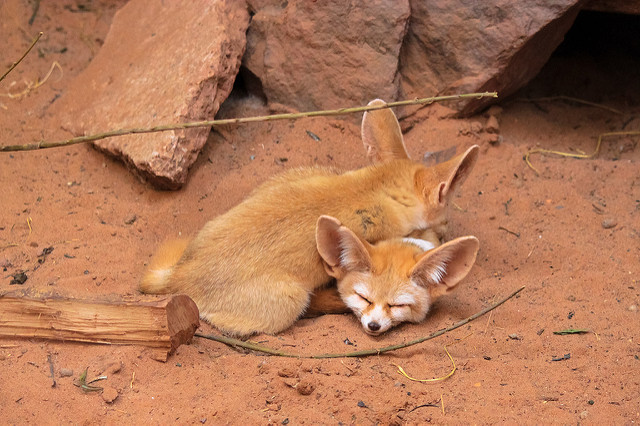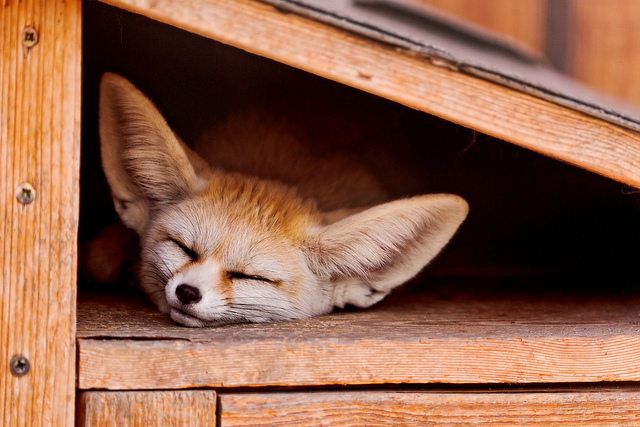We easily recognize them for their over-sized bat-ears, sweet faces and gorgeous colors of grayish or reddish white fur. Fennec foxes are becoming all the rage as popular pets in common households. Everyone knows at least one person that owns these adorable, big-eared foxes, making it easy for the rest of us to forget that they’re also wild and living freely in the Sahara of North Africa. Here are some fun, interesting and wild facts you didn’t know about fennec foxes, Africa’s cutest fox.

Courtesy of Keith Roper/Flickr.com
You can see them in North Africa
See them in their natural surroundings in North Africa, namely Tunisia, Morocco, Algeria, Niger and several more countries. The foxes have the incredible ability to adapt to the harsh desert and live an omnivore lifestyle. They will snack on anything they can find from insects, to plants, to eggs. The foxes also will occasionally eat smaller animals like rats and rabbits, anything they can do to survive. They regulate their body temperature without overheating which is a huge advantage when it comes to living in this unforgiving land.

Courtesy of Lucy Photography/Flickr.com
They can go for a long time without water
Of course, this plays a big role in their survival in the desert. Fennec foxes can go on for an extended period of time without needing water (like many Saharan animals do like camels and lizards). Their kidneys have adapted to retaining and holding more water to prevent water loss. And the foxes can get enough intake of their water fix from their food consumption (plants and animals).

Courtesy of Ernesto Graf/Flickr.com
They’re nocturnal
Don’t worry, this doesn’t mean you’re stuck with having to do a nighttime safari to see them in the wilds of the Sahara. Many fennec foxes can be seen sleeping in view during the daytime, making it easier for tourists to admire them. They adapted to a nocturnal lifestyle since the desert cools down in the evening and poses less of a risk for overheating.

Paul Morris / flickr Creative Commons 2.0
They’re the smallest known fox breed
Their ears, of course, adds height but the foxes are relatively small. They’re the smallest known breed of canid (foxes, dogs, etc) where fully-grown foxes can weigh anywhere from 1.5 to 3 pounds. That’s pint-sized compared to your standard shih tzu!

Courtesy of Tambako the Jaguar/Flickr.com
Thankfully, they’re not endangered
Thanks to the foxes’ extraordinary ability to adapt to an environment that keeps predators at bay (except the Eagle Owl), they are not hunted to near extinction. They are also extremely swift in their movement, making it hard for human hunters to catch them. In other words, they aren’t fun to catch for them. They’re currently on the “least concerned” list when it comes to endangered species.

Courtesy of Derek Keats/Flickr.com
They have extra fluff on their paws
You know how some cats have that extra fur puff on the bottom of their paws? Well, these foxes win the gold medal for having the fluffiest bottom paws of them all. The extra fur plays a role in their ability to adapt to the desert by protecting their feet from burning in the hot sand. These permanent mittens may just be the softest thing on earth.

Courtesy of Andy Hay/Flickr.com
They’re loyal to one mate
The foxes are big on family life where one fox will mate with another for life. A female fennec fox is capable of producing two to five babies a year, which also helps them from hitting the endangered species list. They reach their sexual maturity around nine months, which means it doesn’t take long for them to start breeding adorable offspring.

Courtesy of Marie Hale/Flickr.com
They purr like kittens
This may be why people are so keen to adopt them as pets, the foxes are known to purr when they’re feeling happy or excited. When you come across snoozing foxes in the wild (or in your friend’s house), take time to listen to their sweet sounds.

Courtesy of Tambako the Jaguar/Flickr.com
They hear better than we do
If their gigantic bat-ears haven’t already given it away, they have an advantage over us when it comes to hearing. The foxes can hear the simplest movement from their prey and predators, allowing them to make their attack or dart away to safety. Their ears are the largest known ears of all foxes which is ironic considering the foxes are the smallest breed, too.
More from AFKTravel:
6 Weird Facts You Didn’t Know About Lions
Going Batty – Where To See Bats In Africa
Where To Have The Best Wildlife Experiences In Africa
